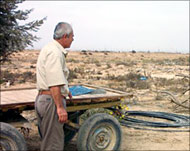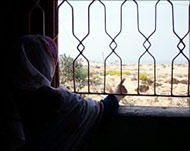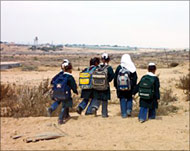Gaza Strip: Israel’s laboratory
At first glance, al-Siyafah may seem like nothing more than a lifeless desert worthy of just passing attention. Dry sandy hills stretch out for several kilometres in all directions, interrupted only by the occasional obstinate bush of wildflowers.

Most people in Gaza, let alone the rest of Palestine probably do not know of this obscure place.
It is the kind of setting favoured by directors of commercials selling cars, which drive past petrol pumps without stopping.
But advertising directors do not come to the tiny Palestinian village of al-Siyafah.
If they did, the cinematic bleakness of the landscape is all they would get. The villagers have little else to offer the visitor to this northwest corner of the Gaza Strip, south of the “no man’s land” separating Israel from Gaza and bordering the Mediterranean Sea.
|
“They told me they would release my brother from prison, and give me all sorts of other goodies if I gave up my land but I refused. Everyone refused, so they decided to take the land by force” |
It is hard to believe that this barren village was once one of the most fertile areas in the entire Gaza Strip renowned for its strawberry, avocado, and guava crops.
That was then. Today al-Siyafah stands as a classic example of what is becoming of Palestinian land as Israel’s policies of isolation and displacement continue.
Since the beginning of the second Intifada, al-Siyafah has been effectively divided into two cantons with the help of a large electrified barbed-wire fence.
Residents of inner al-Siyafa are now completely isolated from those in outer al-Siyafa and from the rest of the Gaza Strip.
Their freedom of movement has been severely restricted, their public services and infrastructure destroyed or limited and their lands annexed. In short, their entire lives are at the mercy of the Israeli military.
Land confiscation
 |
|
Musa al-Ghul looks out over |
In the mid sixties, al-Siyafah was the site of an agricultural development project run by the Egyptian civil administration, which ruled Gaza from 1948 until 1967. Large blocks of fertile land were sold to Palestinian residents for low prices, until war broke out in 1967 and Israeli forces occupied the area.
Since then, Israel has unsuccessfully pressured residents of al-Siyafah to sell or give up their land in exchange for large sums of money and other tempting bribes, according to Musa al-Ghul, the village representative and liaison between the Israeli and Palestinian sides.
“They told me they would release my brother from prison, and give me all sorts of other goodies if I gave up my land but I refused. Everyone refused, so they decided to take the land by force,” said al-Ghul.
Israel established the settlement of Eli Sinai on occupied Palestinian land in Northern Gaza in 1984, after it withdrew its settlements from the Sinai desert.
Later in 1990, more land was confiscated to make way for the settlement of Dugit, located in the very heart of the village of al-Siyafah.
Yet, despite their small numbers, the Israeli military has increased its activity in the area over the past two years as well as its hold on al-Siyafah.
Razed
|
“It was heaven on earth before. Now its misery” |
The entire area of al-Siyafah is about 8 square kilometres in size. Nearly 90% of this land has been completely razed along with 130 water wells, irrigation networks, and greenhouses.
In addition, about 3.2 square kilometres of Palestinian land have been fenced off and effectively annexed by the Israelis.
“Nothing hasn’t been bulldozed here. But we don’t give up easily – we’ve tried to replant trees wherever possible, but nobody wants to help us, they are too scared,” said al-Ghul.
“It was heaven on earth before. Now its misery,” said local resident Um Sufyan, as she points out where her plot of lush farmland used to be.
Um Sufyan lives directly in front of the newly erected fence and no more than 50m away from the Israeli sniper tower located next to the entry gate into inner al-Siyafa.
 |
|
Um Sufyan, points out where |
Um Sufyan’s family, which includes 12 individuals, has had no source of income since the start of the Intifada, when Israelis had demolished their greenhouses.
According to Jacob Pace of the Palestinian Centre for Human Rights (PCHR), razing farms and bulldozing houses is a tactic used by Israel to gain control over Palestinian land.
Some of the land here has already been incorporated into Israeli settlements. Other areas have simply been fenced off or separated from populated areas.
Ethnic cleansing
Many residents of al-Siyafa found it hard to tolerate the Israeli measures in their areas. They have simply fled.
According to the PCHR, at least 37% of the residents have been forced to relocate outside the area to ensure a better standard of living.
“We are always threatened; there is no peace of mind. We hear the bullets flying over our house every night,” said Um Sufyan.
Others, who left temporarily in 2001 to Gaza city, were not allowed back by the Israeli army after a census was conducted to determine who had the right to enter the fenced area. Their lands were subsequently confiscated by the Israeli occupying forces.
Matrix of Control
Since the beginning of the second Intifada, residents of al-Siyafah, and especially those living inside the fenced area, have become subject to what the PCHR refers to as a “matrix of controls”. They are exposed to a variety of humiliating and harassing treatments on a daily basis.
|
“To see the people of the West Bank five years from now, take them to al-Siyafah” Darryl Li, |
Those who want to exit and enter can do so only with special permission from the Israeli army and during a brief window of time that changes randomly.
If someone lives on the outside, for example, and has extended but not direct family living inside, they do not qualify for an entry permit. Um Sufyan has been unable to see her relatives or break fast with them during the holy month of Ramadan.
Currently, the gate opens from 6:30am to 8:00am (04:30 – 06:00 GMT) and from 2pm to 4pm (12:00 – 14:00 GMT). According to al-Ghul, the gate does not always open on time and residents are often forced to wait until the next day.
They must line up near the gate until the appointed time and are then only allowed inside in groups of five.
The Palestinians have to produce identity cards after which they are searched. Since there are few women soldiers serving in the Gaza Strip, Palestinian women passing through to inner al-Siyafa are searched by men.
They are allowed to carry only one plastic bag with goods weighing no more than two kilogrammes and only after a guard dog has inspected the bag.
“Often, the dog does not show up and the food spoils while we wait,” said one resident.
Access denied
 |
|
Israeli travel restrictions deny |
Because of these draconian travel restrictions, residents of inner al-Siyafa are often unable to access basic services in neighbouring towns.
Inside the fenced area, there are no amenities, no clinics, no schools, no shops, no running water, no electricity and no sewage system.
Only registered vehicles may enter the gate. So far, residents have been given permission to use one truck and 14 donkey carts.
Ambulances and cars transporting patients can be stalled for several hours at the gate and school children are forced to walk more than two kilometres to get home.
Trigger-happy soldiers who patrol the fence are known to shoot at residents of the area without apparent cause. A young girl who was shot while playing with her friends near the fence, still has the bullet lodged in her abdomen.
According to the PCHR, Israeli occupation forces have killed at least 19 Palestinian civilians and injured at least 33 others.
It is a grim reminder of what daily life is like for the residents of al-Siyafa.
“We have to remember that the Gaza Strip is Israel’s laboratory,” said formerly Gaza-based American human rights activist Darryl Li.
“To see the people of the West Bank five years from now, take them to al-Siyafah.”